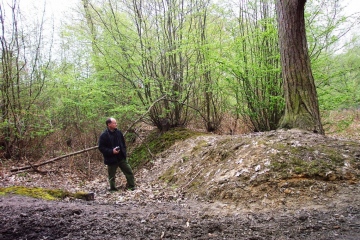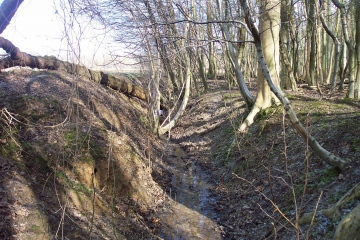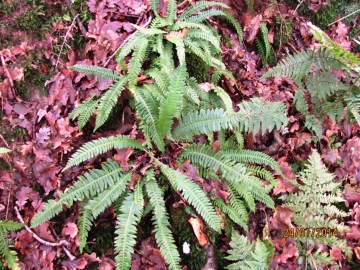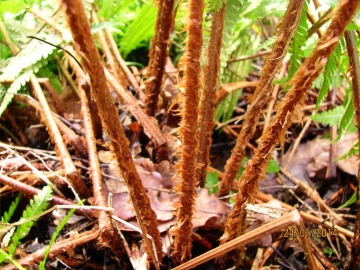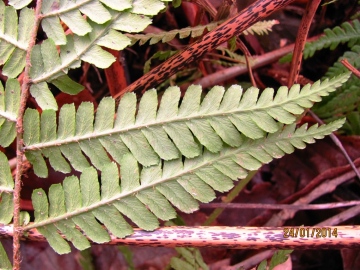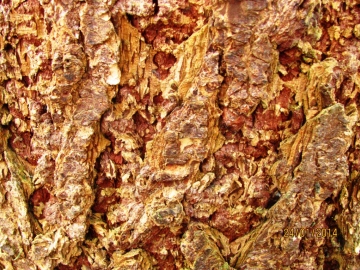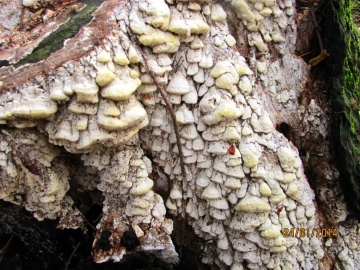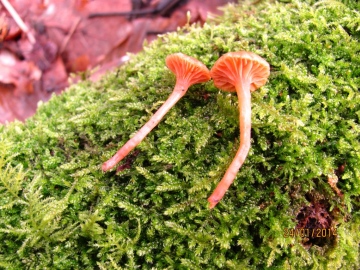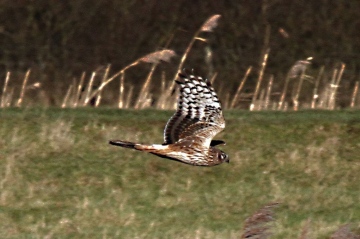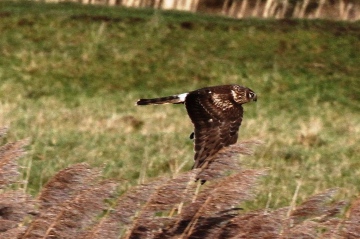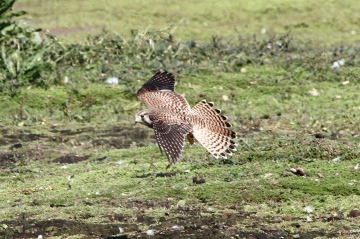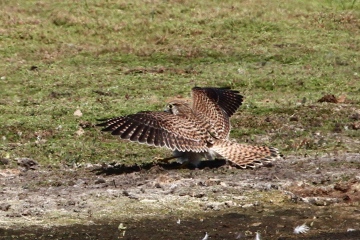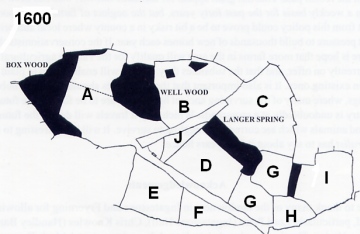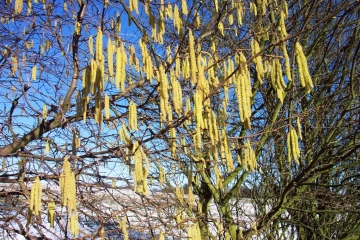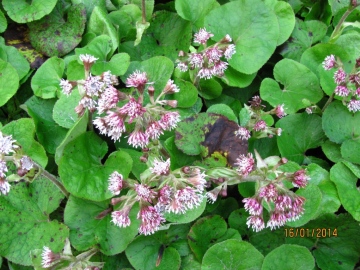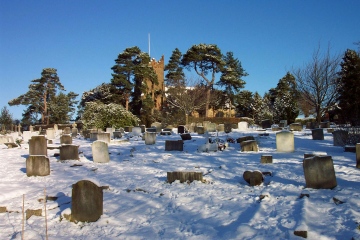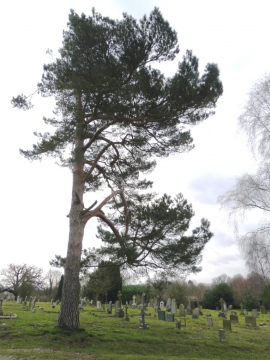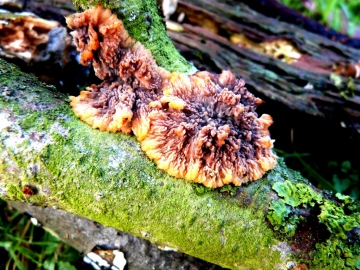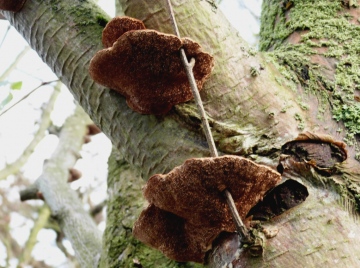Your Forum
The weblog below is for naturalists to use to report interesting sightings, ask questions, report on field meetings and generally post pictures and any information or questions generally relevant in some way to the wildlife and geology of Essex. You will need to register and be logged-on to post to the forum, and you need to upload pictures first, for use in posts. Find out more
|
Fri 31st January 2014 19:10 by Mary Smith Thank you, Graham , again....
...for painting a word picture of the mediaeval serfs or villeins, that made those banks; possibly to be parish borders, or ownership or whatever... And the links with old things like ferns, or trees coppiced or left just to grow any-old-how. And references to Nightingales, and their diminishing numbers. I heard my first Nightingale a few years ago in the south of France, not because we don't have them here (we do!) but I had never been near enough when anyone who knew about them could tell me what they were. In France, an English friend said ' can you hear the Nightingale?' and only then did I appreciate the huge cacophony of sound, with so many variations and so much music in it, that I will remember it for ever! And your writing reminded me of that wonderful sound. Thank you so much, Graham. Wed 29th January 2014 10:30 by Graham Smith Wood-banks
One of those quiet January days when the sun remains but a suggestion of warmth behind a high, thin ceiling of cirrus cloud and the breeze fails to elicit even the faintest rustle from the clusters of keys that still cling stubbornly to the branches of the roadside ash trees. The autumn leaves no longer crinkle underfoot in Stoneymore Wood but subside uncomplainingly into the mud and there is little in the way of sound or colour to penetrate the veil of soft grey light that surrounds the trees and inclines the mind towards reflection.
Wood-banks lend themselves to reflective thoughts. The longest, straightest and mightiest of those that enclose the ancient coppice in Stoneymore is the medieval bank that still forms part of the parish boundary with Highwood. When first constructed it, along with the other banks in the wood, may have been topped with a dead hedge of brash and its ditches periodically cleared of leaves and fallen branches but its original purpose, which was both to define ownership and keep grazing animals (particularly deer and Commoner’s sheep and pigs) from the young coppice within, have long been obscured by neglect. Most people coming across them nowadays would be likely to assume that they are natural features rather than the work of man. Built by men they certainly were but what kind of men? What were they like, those medieval woodsmen who struggled with mattock and shovel to create these once mighty banks? Were they freemen or villeins? Paid for their services by the Lord of the Manor or paying off a debt to him with their toil? What did they think about? Talk about? What were their hopes and fears? At times there seems to be an unbridgeable gap between their age and ours. Ian Mortimer, writing in “The Time Traveller’s Guide to Medieval England†opens his chapter on “The Medieval Character†with a horrendous story about Sir John Arundel – younger brother of the Earl of Arundel – that involves the violent abduction of a group of nuns who, later, are callously dumped overboard when his ship, bound for France, looks like foundering in a gale. He goes on to portray a society where men and women were more “fearful, guarded and violent†than the one with which we are nowadays familiar. It is a world where people have few qualms about inflicting pain on children and animals and where blood sports – Cock Fighting, bull and bear-baiting - are sure to draw a crowd – while the medieval sense of humour revels in the humiliation and misfortune of others. Superstition is rife. Anything is possible. Iron can be turned into gold and Hobgoblins inhabit the woods. It is a frightening age indeed. I’m not sure though that the 14th century has much to teach the 20th about barbarism, more likely the reverse.. And as for cruelty to children and animals, or revelling in the misfortune of others, they are, if not habitual, still commonplace in our society. With regards to superstition, most of us, even today, have a wonderful ability to believe in what we want to believe from time to time, irrespective of the facts, so it is hardly surprising that our medieval forebears believed what they did when they only had their imaginations to guide them. They may have believed that there were Hobgoblins in the wood but, then, only last week a district councillor in the Midlands was sacked for claiming that the recent floods were linked to the legalisation of gay marriage! Human nature doesn’t change that much, would that it did! Its more positive aspects may occasionally come to the fore, depending on the age and society In which we live, but the 14th century is never far below the surface. As I sat on the bank today, coffee cup to hand, viewing those medieval workmen from my elevated vantage point of 600 years, I could at least make a brief nod of recognition in their direction. Doubtless some worked hard while others were loafers; some were garrulous, others taciturn - either ready with a smile or never far from a scowl; some, upon raising their eyes to gaze at the latticework of branches against the sky, were content; others, frustrated by what they saw as the harshness of their existence, gazed at the sky with indifference, hostility even. They probably laughed, swore, larked around, argued, discussed village politics, gossiped and swapped crude jokes. And is it too much of a whimsy to suggest that like the English working class to this day they probably moaned endlessly about both their work and the weather! Were those medieval woodsmen to return to Stoneymore today it would, perhaps, give them pleasure to find that their workmanship had survived for six hundred years but they would undoubtedly be shocked at the condition of the coppice their labours had been designed to protect. It fills me with sadness too. When “Skip†Seymour, my headmaster at Ingatestone Boys’ School in the 1950s, led us pupils on our weekly “nature walk†to Mill Green the wood was full of the song of Nightingales; over thirty pairs he once told me. A dozen pairs remained a few years later, during my bird-nesting youth, and ten or more in the 1970s when my nest finding talents were put to more constructive use on behalf of the BTO’s Nest Record Scheme. Today it is possible to gaze for hundreds of yards through the trees with nary a bramble leaf or blade of bracken to interrupt the view. Nightingales have not bred there for many years, their song slowly fading as the undergrowth in which they nested disappeared. Still, the resumption of commercial coppicing during the past three winters gives hope for the future and, derelict or not, there is still much to enjoy, even in mid-winter. Hard Fern, like these pictured here, have established their only parish site on the wood’s medieval banks, while in damper areas nearby the winter green leaves of Scaly Male Fern catch the eye; the pale centred ginger scales that encrust the stem and the lack of serrations along the margins to the leaf pinnules distinguishing it from its commoner cousin. There is beauty too in the bark of the Douglas Fir – the survivors of another period in the Wood’s history – whose canopies, far above, now top those of the surrounding oaks when viewed from afar. A surprising number of fungi have survived the few frosts this winter – Buttercap, Wood Blewits, Glistening Inkcap, Common Bonnet and Peeling Oysterling. The family Postia is not one to set the pulse racing, most species forming spongy white (occasionally blue tinted) blobs on dead wood but the one pictured here, Postia leucomalella, found covering a rotting Larch stump, cuts a prettier picture, many of the brackets tinted with a delicate buttermilk yellow. Nearby, a common winter species, the Scurfy Twiglet, seemed to be flourishing on an old bonfire site on one of the wood-banks and I hardly gave it a second glance until I noticed the deeply decurrent gills. It proved to be Omphalina pyxidata, otherwise known as the Bonfire Navel, the ‘navel’ being the button-like depression in the centre of the cap. As I paused for a final cup of coffee before returning home a male Tawny Owl roosting in a Scots Pine close by let out his tremulous territorial call, a challenge that met with an immediate response from a rival male on the far side of the wood. For the next ten minutes each tried to out-hoot the other and then their mates joined in, exchanging a sharp “kew-wik†with their rival’s spouse, a swapping of pleasantries that continued as I left the wood and plodded home along the road. Tue 28th January 2014 11:42 by Peter Harvey
I was not saying NBN will be wrong, but that there is no reason in many cases the maps will be comprehensive or often even vaguely so. You also have to remember that even in these days of mass electronic communications, specialists still have to ensure the data is accurate (no mean task) and even more to the point, the data have to be digitised and validated. Can you imagine how long it takes to accurately digitise and then check for errors the vast amount of paper records which exist. Even if you ignored older data and just looked at new data, and assume that all this is already digitised (which will not be true), look at the relatively small numbers of people out there who are regularly recording a group, the need to ensure the data quality is checked and accurate, and that the data doesn't just comprise records of a few easily recognisable species.
I would hope that this website provides a good resource for people with a general interest in what they see around them, for a lot of groups. All this entails huge effort on the part of a lot of people, all done voluntarily, and people should not expect miracles. Tue 28th January 2014 11:22 by Peter Pearson Thanks
Dear Peter, Thanks for your response to my query. I was not assuming that NBN were right in fact quite the opposite, unfornately they are often lacking. I was merely testing the water to see if I was missing observing a common occurence or there was somthing changing here in Essex. An observation though, it seems a great pity in these days of mass electronic communications that there insn't an accurate central data bank that anyone can call on, not necessarily for scientific study, but as in our case, a general interest in what we see around us. Mon 27th January 2014 22:22 by Peter Harvey Alexanders
Dear Peter
There is no reason to suppose the NBN holds comprehensive data on galls, in common with a great many other groups. You cannot therefore assume anything about the distribution of species from maps on the NBN. In Essex there are no maps available on galls other than those published in the past, most recently in the Essex Naturalist vol. 16 (1999) for Essex species of gall-inducing Cynipids on host plants other than Quercus by Jerry Bowdrey. If you want to know about the status of galls in Essex, you need to enquire with Jerry, the County Recorder, see county recorders. Mon 27th January 2014 20:43 by Peter Pearson Alexanders
Graham,
I see that you have posted photographs on this site of galls on Alexanders. On a walk recently my wife and I found the below "galls" on the Alexanders at Skinners Wall, Manningtree. 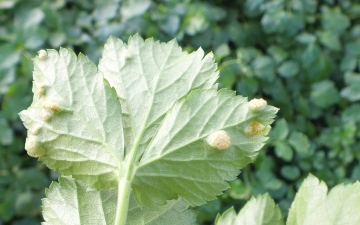 The underside of a leaf. 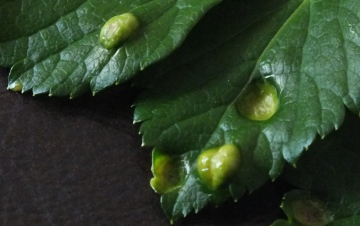 The top of a leaf 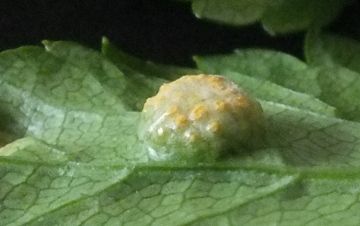 Close up of the underside of a gall On top of the leaf they were green smooth, rounded and greasy in appearance. On the underside they were transparent with yellow cups inside. Each cup had a yellow ball in its mouth. They appeared to progress to a flattened wound on the top of the leaf while below the yellow cups appeared to have emptied and were turning a shade of brown. Not knowing what we had found, I 'Googled' it and came up with a result, the fungus, Alexanders Rust Fungus (Puccinia smyrnii) A question remains, how common is this fungus. NBN Gateway maps show it prevalent on the West Coast, North Norfolk and Suffolk, but none in Essex. Is this a new phenomena in Essex or is a case of under recording. By the way thanks for your excellent forum articles, not my area generally, but none the less a very interesting read. Wed 22nd January 2014 20:44 by Mary Smith Thank you again, Graham
What superb photos! Re Buzzards, I use to look forward to seeing them in the north of Britain when we went on holiday in Scotland, but about 12 years ago there was one soaring on the wind over Cranham, only 1 mile from where I live! Now, they are more commonplace. But Hen Harriers! A different thing altogether!
Somebody ought to raise a campaign to protect ALL our native birds, and send these shooters packing. Yes, I know full well it will take time, but it has been done for foxes, so it could be done for birds of prey as well as other birds that some folk don't like, but only native ones, and regular migrants. But we have alien ones like the Ring-necked Parakeet that comes from the Himalaya regions, and is squeezing out many of our smaller native birds, so maybe the shooters could shoot them! And Canada Geese, but with them you would eat the shot bird, as they are very good, I have been told, but they too are alien pests. Wed 22nd January 2014 16:33 by Graham Smith Hen Harriers
Thought you might like to see these shots of a ‘ringtail’ Hen Harrier taken at Blue House Farm EWT Reserve by John Lilley recently. In this instance the bird was probably a female rather than an immature male, which looks similar, and may well have been the same bird that wintered on the farm last year.
Unfortunately “shot†is an all too appropriate word when applied to Hen Harriers as they are illegally persecuted on their moorland breeding grounds, particularly in northern England and Scotland. Indeed, the RSPB estimate that there is sufficient habitat for around 300 pairs in England, yet last summer only two pairs attempted to nest and both of them failed. The trouble is they feed on small mammals and birds, including grouse chicks, and grouse shooting is worth a lot of money, an estimated £240,000,000 to the Scottish economy alone. If there are huge numbers of fluffy little chicks scurrying about in the heather it would be a dumb bird of prey that did not make the most of this largesse; thus there is a conflict of interest between conservationists and estate managers but nothing can excuse the visceral hatred of “hookbills†and other predators displayed by some in the shooting lobby. When the latter talk of the need to ‘control’ predators, including birds of prey, conservationists can justly point to the Hen Harrier as a case where ‘control’ has become more like extermination. Victorian habits die hard among some in the shooting fraternity! Although such conflicts are normally associated with shooting interests they can be an issue in conservation as well, especially at a local level. There have been instances of serious predation of Sandwich Tern chicks by Grey Herons on Anglesey and in Norfolk and of Little Tern colonies being all but wiped out by Kestrels elsewhere in East Anglia. When you are trying to conserve birds that are facing a number of other threats to their existence such as habitat fragmentation, increased disturbance, and the loss of their principal food supply including – in the case of many seabirds – sandeels (perhaps due to the effects of global warming) heavy predation at a local level can tip the balance. A bird of prey that is currently doing well in Essex is the Buzzard. When I was a boy the idea that Buzzards would one day be a common sight soaring above the woodlands around Ingatestone was beyond my wildest imaginings. Devon was the nearest place you could hope to see them – a rare holiday treat. Yet last year at least five pairs bred in the parish and surrounding area and their beautiful mewing calls were a frequent accompaniment on my walks. They have spread eastwards thanks to a reduction in persecution, at least in southern England, and are now a common sight throughout the county. Now, inevitably, there are calls from some in the shooting lobby that they need to be ‘controlled’. One gamekeeper, interviewed on the BBC’s ‘Country File’ programme, claimed that Buzzards were killing a thousand Pheasant pullets on his shoot each autumn. I think that he was coming it a bit. Ten Buzzards (a ridiculously high concentration in one area except when on migration) would each need to eat a pheasant a day for over three months in order to achieve this level of mortality while three Buzzards (a more realistic figure) would take the best part of a year. And that’s if they ate nothing else. There must be some very fat Buzzards on his estate! Our local gamekeeper did have some trouble with recently fledged young Buzzards trying to make their way in the world, which saw his pheasant pens as a tempting target, but he largely got round the problem by festooning the pens with tinfoil, CDs, tin cans, and other oddments that banged and clattered and flashed silvery in the breeze. Finding alternative, non-lethal, methods to deal with these conflicts (such as supplementary feeding with domestic white rats and poultry chicks in the case of Hen Harriers) is what conservationists and some members of the shooting lobby are attempting to promote but there are some deeply entrenched views out there and they face an uphill task. Many recently fledged young raptors struggle to survive during their first few months of independence – hence the attraction of pheasant pullets – and many die of starvation during this period. The young Kestrel pictured here (also photographed by John at Blue House) found a novel solution. Sun 19th January 2014 07:49 by Mary Smith Graham stars again
Thank you so much, yet again! Are you keeping these extended notes for posterity? A collection could be published. I have always enjoyed your writing, but these recent offerings have been exceptional, in depth and in length, so to speak. Fri 17th January 2014 17:07 by Graham Smith Handley Barns
When King Edgar the Peaceable, who reigned between 959 and 975, reopened Barking Abbey in or around 970 – a hundred years or so after it had been sacked by the Vikings – he presented the Abbess, Wulfhilda (who had earlier spurned his amorous advances), with an estate in Essex that was later to become the parish of Ingatestone. Within that estate was the demesne Manor of Handley Barns; ‘demesne’ being the Lord’s own land or domain, which in theory was farmed directly by him and not held by tenants. In practice however it was often managed by him when agriculture was profitable and handed over to tenants when it was not! Anyway, William the Conqueror allowed the Abbey to retain the land and they held on to it for a further 500 years until the Dissolution of the Monasteries in 1539 when it was purchased by Sir William Petre, Secretary of State to Henry V111. Handley Barns Manor was sold separately, to Elizabeth Hill, widow of Richard Hill, who sold it on to Sir William for £133 4s 6d.
Sir William’s son, John (later the first Lord Petre), commissioned a map of the estate from two of the leading cartographers of the day, John Walker and his son, also John. That depicted demesne land attached to Handley Barns Manor as including Redindyke Farm, properties at nearby Handley Green, and what are now called Mill Green Common and Stoneymore Wood but which at the time were known as Handley Common and Great Handley Wood. In time, Common and woods became part of the Writtle Park estate, purchased by Sir William from Queen Mary in 1554. Handley Barns Farm though has changed very little in the five centuries since then. In 1600 the farm comprised around 130 acres of meadow and pasture and three small ancient woodlands, Box & Well Woods and Langer Hedge. The first two remain, the last has gone, but was replaced in the late 16th or early 17th centuries with Gust Leaze, later renamed Bushy Wood. Field boundaries have been tweaked and land use has changed in line with agricultural fortunes (the marshy meadows alongside a stream have recently been replaced by the largest in a series of fishing lakes) but in 2014 it is essentially the same farm as in 1600 and quite possibly 1066 as well, or even earlier. One of the fields on the farm is a designated Roman site, possibly concealing the remains of a villa, and finds there in the past have included coins depicting Hadrian (117-138), Marcus Aurelius (161-180) and the latter’s wife, Faustina, who does not appear to have been a very nice person at all, to put it mildly! This is what makes Handley Barns a very special place.
When I was at primary school in the 1950s we had a teacher for a few months called Dave Sorrel. One day he took us for a walk to Box Wood and we spent a couple of hours happily rooting around in the leaf litter digging up shards that had been dumped from a pottery which had once existed on an adjoining farm. On returning to school we cleaned the shards and he identified them for us, teaching us a little about the era in which they had been made. If I had but realised it at the time he prised open a window on a subject that interested me; a window that was slammed firmly shut in Secondary School but which, in later life, was flung wide when I stumbled across the books of Oliver Rackham. These were a revelation. There was I, a country boy through and through, who had walked the parish fields and woods hundreds of times with his parents when a youngster, and bird-nesting friends as a boy, yet was completely unaware that the landscape I was walking in had a history. Suddenly, woods and meadows, hedgerows, pollards, ponds and coppice stools had context and meaning. Not only that but the plants that grew in them, the birds that nested in them, the butterflies and moths that supped nectar from their flowers and whose caterpillars fed on their leaves, the dragonflies that danced above the ponds; even the mushrooms that I picked in the meadows, all were inextricably linked to the history of the landscape in which they lived. Birds had always been my ‘thing’ since I was knee high to a grasshopper but Oliver’s books opened my eyes and broadened my interest so that natural history and human history became indivisible. A walk would never be the same again. I cannot thank the Professor profusely enough! This will teach you to pay me compliments…………………………… Anyway, Handley Barns was where I was today, completing a Winter Thrush Survey for the British Trust for Ornithology. Birds have had it easy this winter compared with last, when three months of unrelenting easterlies from the Russian Arctic killed so many. Ground nesting birds such as thrushes have benefited from all the rain; worms, forced to the surface, almost giving themselves up so sodden is the soil. They and other birds are already looking forward to the spring. Blackbirds are becoming territorial, Blue Tits are busily courting and Song Thrush, Mavis, Tom Tit, Redbreast, Hedge-e-Bet and Jenny Wren are all in song. Bluebells, Daffs and Cuckoo Pint are pushing through the mud; Snowdrops are in bloom in the village gardens; Hazel catkins are shedding sheets of pollen on the breeze
And finally, you never stop learning, or at least you shouldn’t. I have even learned to love Brussel Sprouts, after refusing to go near them as a kid unless they were buried in Bubble & Squeak. What I do not seem to have learned is that if you trip or slip while sauntering along with your hands in your pockets the first thing to hit the ground is likely to be your nose! Oh well, at least the ground was soft today………………… Mon 6th January 2014 11:25 by Enid Barrie Very interesting Graham!
Really enjoyed reading about Fryerning...thank you for writing this. I am pleased that we are getting told on the EFC facebook page of postings on the Forum so we don't miss anything!
There seems to be an amazing amount of fungi species at Fryerning. What a shame about the falling trees. I wish more churchyards were better managed for wildlife as you are doing there. Marion and I visited quite a few Essex churchyards in 2013 and could see many missed opportunities although some are trying. Tidiness is still a priority for many. Sun 5th January 2014 20:23 by Mary Smith Thank you, Graham.
What a lovely way you have with words, to paint word-pictures of history as well as the present, and with real pictures as well.
Your query about why trees are falling down more than hitherto:
One obvious suggestion is that as the trees age, they are more likely to fall over, especially noticeable if the current trees were mostly planted at about the same time and thus ageing together.
Another suggestion is that global warming would be expected to bring more energetic and thus chaotic weather, causing more extremes of weather. Since the gale of 1987, gales have been more frequent, often accompanied by heavy rain, and it is no surprise, then, that more trees are falling down. Given the extreme weather of the past 3 or 4 weeks, even more trees are falling over or losing big branches!
With a bit of luck, spring is not too far away and trees will leaf again and the sun shine. Well, no harm in hoping! Fri 3rd January 2014 19:44 by Graham Smith Fryerning Churchyard
Fryerning Church stands at the southern tip of the Fryerning-Mill Green ridge and offers fine views across the gentle rise and dip of the Essex countryside towards the much steeper hills of the Epping uplands. St Mary’s has occupied this spot since the 11th century (or at least the Nave has) but the church is positioned on a raised embankment and it is thought that in all probability the site was in use as a defensive position long before that. It was no use against the Normans though and William the Conqueror usurped the Saxon owners of the estate on which it stands and gave it to Robert Gernon, one of his Barons. He in turn bequeathed it to his grandson, Gilbert Montfichet, who passed it on to the Knights Hospitallers of Jerusalem, a religious order linked to the Crusades. It was they who replaced the original wooden tower with an impressive brick one in the 15th century. No sooner had they done so than Henrry V111 fell out with the Catholic Church and the Dissolution of the religious houses was the result. The estate, including the church, was eventually acquired by Nicholas Wadham, who was married to Dorothy, daughter of Sir William Petre, the new owner of adjoining Ingatestone following the demise of Barking Abbey. It was this couple who founded Wadham College, Oxford and the college has been patron of the living of Fryerning Church ever since.
The Normans certainly had defence in mind when they built the Nave as the walls are three feet thick and the five narrow windows are situated fifteen feet from the ground, an ideal position from which to rain arrows on rebellious Saxons, minor local uprisings being not uncommon nationwide following the Battle of Hastings. Uppity Saxons apart the old church has seen many a verbal battle over the centuries between the various incumbents, the church authorities and their tithe paying parishioners, squabbles which viewed from this distance in time often seem trivial, as indeed do many that bedevil the Anglian Church to this day. No matter. It is a peaceful spot – the sort of churchyard where it would not seem amiss to picnic – and it is a joy to linger awhile on a Sunday morn, listening to the bell-ringers go through their paces, or to potter about enjoying the wildlife that thrives there. Alas, the church itself is no longer open to the public except on High Days and Holidays as last year there were a couple of thefts, including an antique chair valued at £200, and the doors are now locked. A few years previously the heavy oak Lych Gates were nicked and later turned up in a drug dealer’s house at Romford along with, curiously enough, a generator that had been stolen from our Bird Hut at Bradwell. Apparently the dealer was accepting various items from addicts in lieu of cash and then selling them on and it was probably one of his disgruntled clients that shopped him. The policeman in charge of the case reckoned that they cleared up sixty burglaries in one go and was chuffed to bits. Anyway, pottering about was what I was doing this morning during the couple of hours of pleasant sunshine that preceded another bout of gales and rain. The Christmas storms had brought down numerous branches on the pines and other trees and I was cutting them up and rebuilding the log pile in the conservation area. There has been a terrible toll of the churchyard’s trees during the past decade and it is difficult to understand why. Prior to that the occasional tree had succumbed of course but the losses since then have averaged one a year. First to go was a magnificent Indian Cedar which, if I read the rings correctly, was planted at the time the coronation of George V. It was killed by Honey Fungus. A mature Silver Birch followed soon afterwards, attacked by Shaggy Scalycap and eventually polished off by Birch Polypore. A Horse Chestnut, Indian Horse Chestnut, two Japanese Cherries, two Swedish Whitebeams and a Beech followed in quick succession, on the last of which Mary found the remains of a Porcelin Fungus during the Club Waxcap Foray in November. The latest victims are a fine old False Acacia and the Scots Pine pictured here. The pine is under assault by three different parasitic fungi – Pine Firefungus, Root Rot and Dyer’s Mazegill – which seem to take it in turn to have a go from year to year. No wonder all the branches have fallen off one side of the tree! Found a surprising number of common fungi on the rotting wood on the two log piles during my tidying up : Wrinkled Crust Phlebia radiata (below), Turkey Tail Trametes versicolor, Smoky Bracket Bjerkandera adusta, Crystal Brain Exidia nucleata, Coral Spot Nectria cinnabarina and the Blushing Brackets Daedaleopsis confragosa, pictured here, two of which seem to have engulfed the small branch in the foreground as they developed rather than the branch growing through them. This species is common everywhere, on all manner of dead or dying deciduous trees, but I found on consulting my records that it had not turned up in the churchyard before. One new addition in early January to a list that is approaching 300 was pleasing enough but I added two more before my work was complete : Mycena clavularis, a tiny white-capped species found growing on the mossy trunk of a recently toppled Japanese Cherry, and the Elastic Oysterling Panellus mitis, on the rotting branch of a Scots Pine. A very good start to the season!
As I left the churchyard the cloud was tumbling in from the west and the bare branches of the trees were being tossed about by the gale. A Mavis – my favourite winter songster – began singing from the trees that line the garden of the Old Rectory; a sad, wistful, quietly spoken refrain with none of the Song Thrush’s optimism for the coming spring, best heard at a distance when the clouds are gathering and the wind blowing, hence the old country name of Stormcock. |
Archives: May 2020Aug 2019 Jan 2019 Sep 2018 Jul 2016 Oct 2015 Jul 2015 May 2015 Apr 2015 Mar 2015 Feb 2015 Jan 2015 Dec 2014 Oct 2014 Sep 2014 Aug 2014 Jul 2014 May 2014 Apr 2014 Mar 2014 Feb 2014 Jan 2014 Dec 2013 Nov 2013 Sep 2013 Aug 2013 Jul 2013 Jun 2013 May 2013 Apr 2013 Mar 2013 Feb 2013 Jan 2013 Dec 2012 Nov 2012 Oct 2012 Sep 2012 Aug 2012 Jul 2012 Jun 2012 May 2012 Apr 2012 Mar 2012 Feb 2012 Jan 2012 Dec 2011 Nov 2011 Oct 2011 Sep 2011 Aug 2011 Jul 2011 Jun 2011 May 2011 Apr 2011 Mar 2011 Feb 2011 Jan 2011 Dec 2010 Nov 2010 Oct 2010 Sep 2010 Aug 2010 Jul 2010 Jun 2010 May 2010 Apr 2010 Mar 2010 Feb 2010 Nov 2009 Oct 2009 Aug 2009 Jul 2009 Jun 2009 May 2009 Apr 2009 Mar 2009 Feb 2009 Jan 2009 Nov 2008 Oct 2008 Sep 2008 Aug 2008 Jul 2008 Jun 2008 May 2008 Apr 2008 Mar 2008 Feb 2008 Jan 2008 Dec 2007 Nov 2007 current posts |



















